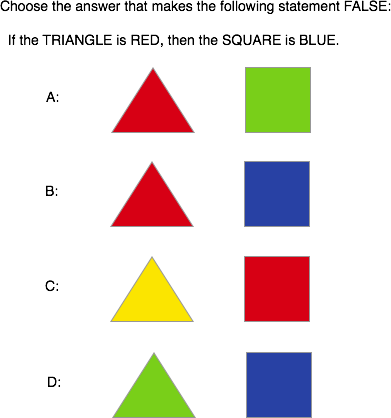Why technical explanation alone is not enough
Here's a problem you might see on a standardized test:

Go ahead and try to solve it. Choose an answer.
When people answer this question on a test, the most common answer is C. Yellow triangle and red square. They try to make the statement false by negating all of the colors.
This is wrong. The correct answer is A. It is the only one that makes the statement false. Why?
This is a propositional logic problem. The colors and shapes are a red herring. The rule for implication (if-then statement) is:
An implication is false if the antecedent is true and the consequent is false.
Kind of boring and therefore hard to understand if you don't already know the rule. It is unlikely that any amount of explanation will help, though you should try to understand if you don't already. Here, try this. If the triangle isn't red, then the statement doesn't apply, so it is true by irrelevance. That eliminates C and D. B makes the statement true, so it must be A.^1
Researchers found that explanations alone do not help. I read an article^2 about a study where similar questions were asked to a group of students. The students were hooked up to EEG (Electroencephalography) machines to measure what parts of their brains were active during each question. They also asked them to say which ones they thought they got right.

Photo credit: Petter Kallioinen
What they found was that most of the people who answered A were using their frontal and temporal lobes: the parts of the brain responsible for logic, reasoning, and language. Most of the people who answered C were using their occipital lobes, which are responsible for vision.
Moral #1: Recognize what type of problem you need to solve. If possible, use the right part of your brain for that problem.
The people who used their vision centers were doing visual pattern matching, looking for shapes and colors. This is typical of a fight-or-flight response, where you are running from a tiger and need to quickly spot it in the jungle.
Moral #2: Don't get nervous during a test. Anxiety makes some parts of your brain more active---usually the wrong ones.
In addition, the people who used their vision center to answer the question thought they got the answer right just as much as the people who did get it right.
Moral #3: The different parts of your brain are good at different tasks. If you ask the occipital lobe to do pattern matching, it will, and it will think it did a good job---even if it is not a pattern-matching task.
The second part of the study tried to teach those who got it wrong to do it better next time. They broke them into a control group and an experimental group. The control group got an explanation like the boring one above on how to make an implication false. The experimental group got the same explanation plus they were trained with a little bio-feedback to use the right part of the brain.^3
The result was that the control group didn't make any gains. And they still thought they got it right. The experimental group did significantly better. They scored higher and were more likely to say they got the wrong answer when they did get the wrong answer.
Moral #4: Explanation alone is basically worthless. Even practice is not enough. The key is to recognize what type of problem it is, use the right part of your brain, and don't listen to the rest of your brain. Only then is explanation useful.
Now, this is easier said than done. I don't have an EEG machine. I've never done bio-feedback. But the idea has helped me tremendously when teaching math. It is not hard to recognize when someone is using the wrong part of their brain. First, they confidently get the wrong answer. Second, they are getting the basic mechanics of the problem wrong. They're looking for something. They find the closest thing to what they want. They're done.
Logic problems aren't about looking. They're more abstract. Common helpers for doing logic problems are mouthing words, making gestures, and looking away from the problem.
Recognizing whether someone is using the right part of their brain is easy. But now you know explaining won't help. The hard part is to get them to use the correct part of the brain. That's what I'll talk about next time.
If you still don't get it, I'll share one more trick. Convert it into a purely symbolic puzzle to switch off your occipital lobe.
Choose the answer that makes the following statement FALSE:
X -> Y
A. X & ~Y
B. X & Y
C. ~X & ~Y
D. ~X & Y
I read it back in 2002 and have lost the reference. I tried searching for it and could not find it. The reason I bring it up, even without a citation, is that it has been very important to my thinking about learning. If you know this or a similar study, please let me know.
Yes, it was double-blind. If I remember correctly, they were all in the same classroom listening to the same lecture. The control group was moved to a room to practice. The experimental group was moved to a different room to practice with EEG bio-feedback machines. Then they took a similar test again.